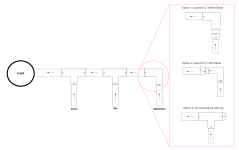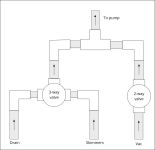I currently have 1.5" pipes throughout the system (including underground) and I am redoing the plumbing on the pad to 2". On the suction side, I have three 1.5" lines coming up next to each other which I will combine into one 2" line feeding into the pump. My question is, when expanding from 1.5" to 2" on a 90° degree turn, is it better (i.e., less head loss) to expand before or after the turn? Or should I use a 2"-2"-1.5" reducing tee which would make it look more consistent with the other two lines and cap off the other end? Or does it not make a difference from a flow standpoint? My initial thought was to use a 2"-1.5" reducing elbow (in the red circle in the diagram below) but I can't find one at the big box stores, so I am looking for the most efficient replacement.
Diagram (hope this make sense):

Second question: Does it matter which order the lines are in? Based on where the pipes come up from the ground, the drain has to be last in line (i.e., closest to the pump), but the vacuum line can either be in the middle (as shown above) or the first in line (i.e., the one with a 90 instead of a tee). Is that preferable?
Thanks everybody!
Diagram (hope this make sense):

Second question: Does it matter which order the lines are in? Based on where the pipes come up from the ground, the drain has to be last in line (i.e., closest to the pump), but the vacuum line can either be in the middle (as shown above) or the first in line (i.e., the one with a 90 instead of a tee). Is that preferable?
Thanks everybody!


